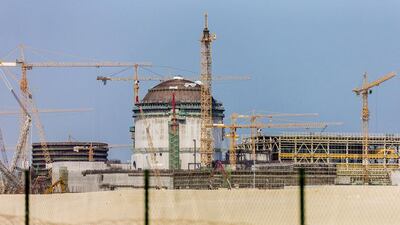The International Atomic Energy Agency (IAEA) gave the UAE’s nuclear safety plan a mixed report card following an 11-day review by a team of international inspectors.
The UAE has been looking to get an early clean bill of health from the UN’s nuclear watchdog as it progresses towards becoming the first country in the region to add nuclear to its energy mix, with the first units at Barakah, located about 280 kilometres south-west of Abu Dhabi city, slated to begin operation in late 2017.
“The UAE has built its nuclear emergency preparedness and response programme in an effective way on the basis of an already strong national infrastructure for crisis and emergency management,” Raoul Awad, the head of safety at Canada’s nuclear regulator, who headed the IAEA’s mission, said.
“The partnership between the National Emergency Crisis and Disasters Management Authority, the Ministry of Interior, the Federal Authority for Nuclear Regulation and the Emirates Nuclear Energy Corporation is key to the success achieved thus far,” Mr Awad added.
In its report, the IAEA praised various aspects of the UAE’s safety plan, particularly its unique co-location of onsite and offsite emergency operations centres at Ruwais, near Barakah.
This is in apparent recognition of the lessons learnt from previous nuclear accidents, especially the disaster at Fukushima, Japan, four years ago, when the risks to citizens came from evacuation rather than directly from damage to the nuclear units.
The UAE approach “can greatly enhance the effectiveness of the cooperation between the operator and the offsite emergency management authorities, a key to the success of any emergency response”, the IAEA report said.
However, it also said there was room for improvement.
Specifically, the IAEA was concerned about arrangements to protect and inform the public, as well as the training of safety staff in various relevant agencies.
Despite the shortcomings, the UAE is on track to have its safety arrangements in place well before other countries that have gone down the nuclear road, said a UAE nuclear official, who did not want to be quoted.
He noted that a previous IAEA mission in February highlighted the rapid progress on another key safety regime – the Integrated Regulatory Review Service – which was nearly complete. India, which has an advanced nuclear programme, just completed its IRRS last week.
The UAE’s nuclear programme is being closely watched as the first due to come onstream in the region, where dozens of nuclear plants are at various stages of planning.
The first of the four South Korean-designed plants in Barakah is due to be operational in 2017, with the others coming on every subsequent year to 2020, when total capacity is expected to be 5,600 megawatts.
amcauley@thenational.ae
Follow The National's Business section on Twitter

